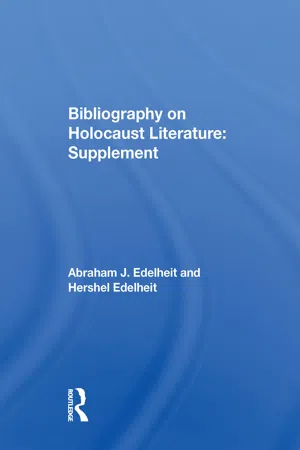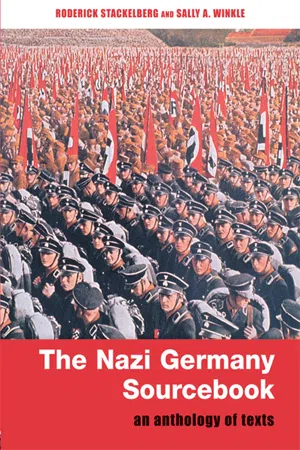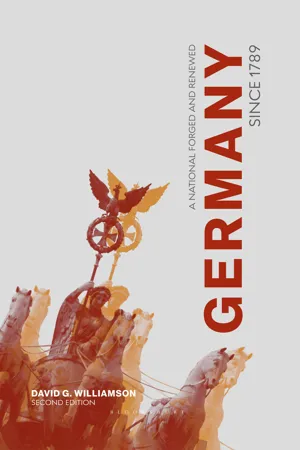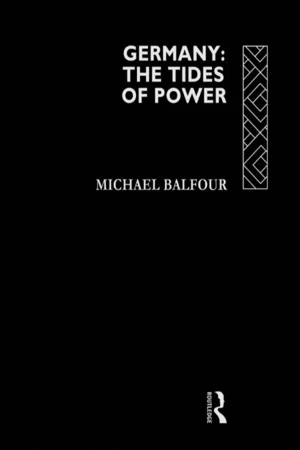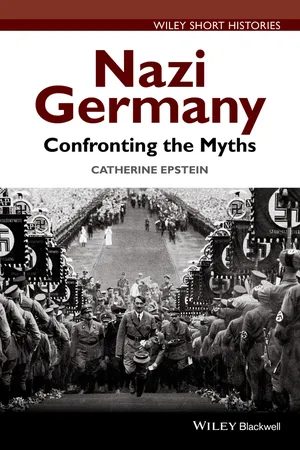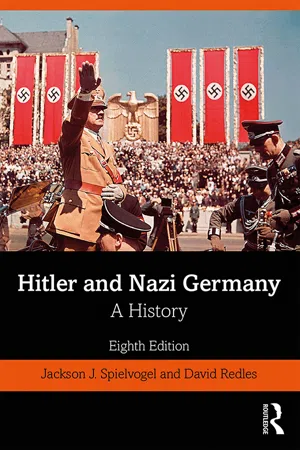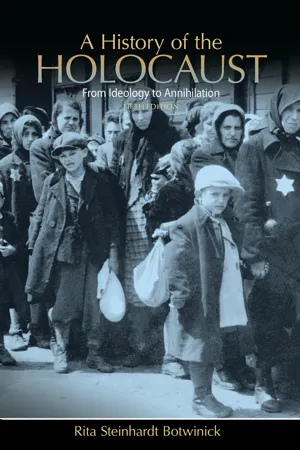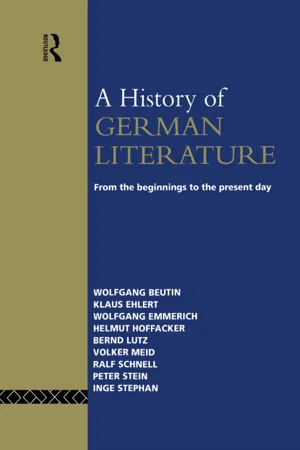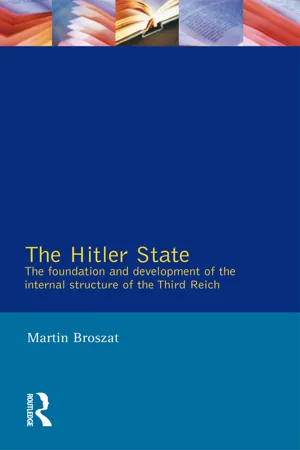History
Third Reich
The Third Reich refers to the Nazi regime in Germany from 1933 to 1945, under the leadership of Adolf Hitler. It was characterized by totalitarian control, aggressive expansionism, and the implementation of racist policies, including the Holocaust. The term "Third Reich" reflects the Nazi ideology of creating a new, powerful German empire, following the First Reich (the Holy Roman Empire) and the Second Reich (the German Empire).
Written by Perlego with AI-assistance
Related key terms
10 Key excerpts on "Third Reich"
- eBook - ePub
Bibliography On Holocaust Literature
Supplement
- Abraham J Edelheit(Author)
- 2021(Publication Date)
- Routledge(Publisher)
3Nazi Germany DOI: 10.4324/9780429033353-4A. THE Third Reich1. Overviews
- 388. Barth, Hans: "Reality and Ideology of the Totalitarian State." Tr. from German by George Wack. R/P , v.l #3 (July, 1939): 275-306.
- 389. Bendersky, J.: A HISTORY OF NAZI GERMANY. Chicago: Nelson-Hall, 1985. 267 p. *** Reviews the origins and development of Nazism; the seizure and consolidation of power; the Nazification of German society; Hitler's anti-Jewish policy and the SS terror; World War II and the fall of Nazi Europe.
- 390. Black, Robert: FASCISM IN GERMANY: HOW HITLER DESTROYED THE WORLD'S TOST POWERFUL LABOUR MOVEMENT. London: Steyne Publications, 1975. 1,240 p. *** Documents the role big business played in financing Hitler's rise to power. Also examines the organization and policies of the German labor movement. Posits that the divisiveness between the Social Democrats and Communists aided the Nazis in their rise to power.
- > #5433. Boehm, E.: Policy Making of the Nazi Government.
- 391. Bonn, M. J.: "The Political Situation in Germany." PQ , v.4 #1 (Jan./March, 1933): 44-57.
- 392. Brown, H.: "Bloody Hitlerland: Under the Swastika!" JTr , v.10 #24 (Aug. 18, 1933): 7. *** Eyewitness account.
- 393. Carr, Joseph J.: THE TWISTED CROSS. Lafayette, LA: Huntington House, 1985. 310 p.
- 394. David, Claude: HITLER'S GERMANY. Tr. from German by Anne-Marie Geoghegan. New York: Walker, 1963. 154 p.
- 395. Duffield, Marcus: "Hitler's Germany." CH/F , v.51 #3 (Nov., 1939): 12-14.
- 396. Elliott, B. J.: HITLER AND GERMANY. White Plains, NY: Longman's, 1980. 176 p.
- 397. Fay, Sidney: "Germany under the Iron Heel." CH/F , v.38 (Apr., 1933): 102-105.
- 398. ---: "Hitler: Chancellor of Germany." CH/F , v.37 (March, 1933): 741-748.
- 399. ---: "The Hitler Dictatorship." CH/F , v.38 (May, 1933): 230-234.
- 400. ---: "Is the Nazi Revolution Ended?" CH/F , v.38 (Sept., 1933): 741-747.
- 401. ---: "The Nazi Totalitarian State." CH/F , v.38 (Aug., 1933): 610-618.
- 402. ---: "The Nazis' Birthday Party." CH/F
- eBook - ePub
The Nazi Germany Sourcebook
An Anthology of Texts
- Roderick Stackelberg, Sally A. Winkle, Roderick Stackelberg, Sally A. Winkle(Authors)
- 2013(Publication Date)
- Routledge(Publisher)
The Third Reich The consolidation of Nazi rule, 1933–35One day after Hitler’s appointment as chancellor he issued an optimistic proclamation to the people in the name of his new government (Doc. 3.1). Its conservative, revivalist, law-and-order tenor was designed to appeal to the millions of Germans who blamed the parliamentary system, partisan politics, and the Marxist left for the gridlock in national politics. To members of the military and industrial elites Hitler revealed his long-term aims (Docs. 3.2 and 3.3): Destruction of the parliamentary system, suppression of the left, creation of a national dictatorship, rearmament, reversal of the Versailles treaty, and preparations for war, should that become necessary to meet Germany’s supposedly legitimate need for more territory.The new regime called for new elections on 5 March 1933 in the hopes of using its incumbency and the machinery of state to obtain the two-thirds majority required to legally change the constitution. The Nazis also launched a campaign of violent persecution against political opponents on the left, particularly leaders and functionaries of the Communist and Social Democratic Parties (Doc. 3.4). The fire that destroyed the interior of the Reichstag building in Berlin on the night of 27 February 1933, in the last week of the election campaign, gave the Nazis the opportunity to suspend civil liberties and and repress the Communist opposition under full legal cover (Doc. 3.5). Hermann Goering, as Minister of the Interior in the state of Prussia, authorized the deputization of SA and SS personnel (Doc. 3.6). Yet despite all the resources at their command, the Nazis failed to obtain even a simple majority of the vote in the last election of 5 March 1933 (see Table 2.1 - eBook - ePub
Germany since 1789
A Nation Forged and Renewed
- David G. Williamson(Author)
- 2015(Publication Date)
- Bloomsbury Academic(Publisher)
As Saul Friedländer observed, reunification had ‘given back natural continuity to German history’. 11 Over the last two decades or so historians have moved on from the structuralist–intentionalist debates to exploring such questions as the modernity of the Third Reich, its social and economic legacy to the Federal Republic and how individual Germans responded to the Volksgemeinschaft (see p. 254). As Detlev Peukert has reminded us, the paradoxical association of the concepts of ‘normality and modernity’ with ‘fascist barbarism’ in the Third Reich raises fundamental questions about the ‘pathologies and seismic fractures within modernity itself, and about the implicit destructive tendencies of industrial class society’. 12 The political structure of the Third Reich The Third Reich was a polycratic regime ultimately subordinated to Hitler, but characterized by rival hierarchies and centres of power as well the lack of a clear command structure. It is possible to distinguish the following distinct centres of power, although there was some overlap between them: • the central government with its traditional ministries and civil service; • the emergence of the SS state under Himmler by the end of the 1930s; • the single-party monopoly of the Nazi Party; • the charismatic dictatorship of Hitler. Central government When Hitler came to power he had no detailed plans for creating a specifically Nazi state as such. Nevertheless he was determined to have a pliant state that would enable him to implement his aims of territorial expansion, mobilization of the population and ultimately the racial re-ordering of Europe. His approach was pragmatic - eBook - ePub
West Germany
A Contemporary History
- Michael Balfour(Author)
- 2023(Publication Date)
- Routledge(Publisher)
4 The Third Reich, 1933–1945The Totalitarian State
Part of the Nazi technique lay in never allowing their competitors a letup or the German people a dull moment. No sooner was Hitler installed as Chancellor than another election was announced – the third in eight months. The propaganda machine, which now had full access to the radio system, was turned on in full strength (subject only to the discovery that Hitler was a poor speaker in the studio). The storm-troopers, 40,000 of whom were taken on as auxiliaries by the Prussian police, were let loose in the streets. We are unlikely ever to know for certain how the Reichstag building was set on fire on the night of 27 February; it is perfectly possible that the half-witted Dutchman found inside really did the job on his own. What is beyond dispute is the energy with which the Nazis exploited the supposed Communist conspiracy. On the following day, Hindenburg was induced to sign an emergency decree suspending many of the vital personal liberties, authorising the Reich Government to interfere in the Länder and making death the penalty for a number of crimes.But when the Election came on 5 March, the result was far from being the triumph which was represented. 13 million out of 32 million voted for democratic parties and the Communists lost no more than 19 seats; the Nazis only won 43.7 per cent of the poll and were left relying on the Nationalists for a majority in the Reichstag. When it met, the Deputies were presented with an Enabling Bill which would for five years authorise the Chancellor, without reference to the President and irrespective of what might be said in the Constitution, to issue laws on any subject he chose. Only one Deputy (a Social Democrat) spoke against it and only Social Democrats voted against it (the Communists having already been proscribed). Hitler thus made himself dictator by legal methods while the Reichstag abdicated its functions and henceforward only met at intervals to be harangued. - eBook - ePub
- Michael Balfour(Author)
- 2004(Publication Date)
- Routledge(Publisher)
4 THE Third Reich: 1933–1945
THE TOTALITARIAN STATE
Part of the Nazi technique lay in never allowing their competitors a let-up or the German people a dull moment. No sooner was Hitler installed as Chancellor than another election was announced—the third in eight months. The propaganda machine, which now had full access to the radio system, was turned on in full strength (subject only to the discovery that Hitler was a poor speaker in the studio). The Storm-Troopers, 40,000 of whom were taken on as auxiliaries by the Prussian police, were let loose in the streets. We are unlikely ever to know for certain how the Reichstag building was set on fire on the night of 27 February; it is perfectly possible that the half-witted Dutchman found inside really did the job on his own. What is beyond dispute is the energy with which the Nazis exploited the supposed Communist conspiracy. On the following day, Hindenburg was induced to sign an emergency decree suspending many of the vital personal liberties, authorizing the Reich Government to interfere in the Länder and making death the penalty for a number of crimes.But when the election came on 5 March, the result was far from being the triumph which was represented: 13 million out of 32 million voted for democratic parties and the Communists lost no more than nineteen seats; the Nazis won only 43.7 per cent of the poll and were left relying on the Nationalists for a majority in the Reichstag. When it met, the Deputies were presented with an Enabling Bill which would for five years authorize the Chancellor, without reference to the President and irrespective of what might be said in the Constitution, to issue laws on any subject he chose. Only one Deputy (a Social Democrat) spoke against it and only Social Democrats voted against it (the Communists having already been proscribed). Hitler thus made himself dictator by legal methods while the Reichstag abdicated its functions and henceforward met only at intervals to be harangued. - eBook - ePub
Nazi Germany
Confronting the Myths
- Catherine A. Epstein(Author)
- 2014(Publication Date)
- Wiley-Blackwell(Publisher)
Chapter 4 . While racism generally heightened the regime’s appeal, coercion cut many ways. Many Germans appreciated the suppression of leftists yet disliked arbitrary Nazi terror. At the same time, the threat of coercion may have kept some from voicing discontent. As this chapter argues, even if most Germans were not enthusiastic Nazis, they nonetheless came to accept the Third Reich. They shared the fundamental values and goals of Nazism: racism, anti-Marxism, and German national revival.The Economy
Nazi economic policy makes sense only if viewed in the context of Hitler’s greater goal of securing Germany’s future through the acquisition of Lebensraum (living space). The Führer was bent on making Germany an economic rival to the United States; otherwise, he feared, Germany would be enslaved to the world Jewish conspiracy. In his view, Germany could only rival America if it had a larger population and expanded territory. To secure Lebensraum, Hitler would have to go to war and, for that, he needed a strong armaments industry. But he faced a predicament: Germany’s productive capabilities posed numerous challenges to his goal of national regeneration.Hitler faced another conundrum, too. He wanted worker support for the eventual war he planned to launch. At the same time, though, he and the conservative elites that supported him were eager to alter industrial relations so as to weaken workers’ influence. Already in spring 1933, Hitler had crushed the independent workers’ movement (see Chapter 3 ). Moreover, the German economy remained decidedly capitalist, favoring the interests of the state and big business over those of workers. Hitler was thus anxious about maintaining the support of German workers.An economic miracle?
Scholars used to think that Nazism brought an economic miracle. On June 1, 1933, the Nazi regime implemented the Reinhardt Plan, one billion Reichsmarks devoted to work creation. Unemployed Germans were put to work on infrastructural improvements, especially in underdeveloped regions. By fall 1933 the number of unemployed had fallen from six to four million. Nazi propaganda trumpeted regime successes in the “battle for work.” In the next years, additional Nazi policies further lowered unemployment. In 1935, for example, the Nazis made service in the Reich Labor Service (Reicharbeitsdienst) mandatory for all young men. Among other projects, Reich Labor Service workers reclaimed some 1.8 million acres of marsh and other land for agricultural purposes. Still, economic recovery took longer than anticipated. Two million Germans had no work in winter 1935–1936. - eBook - ePub
Hitler and Nazi Germany
A History
- Jackson J. Spielvogel, David Redles(Authors)
- 2020(Publication Date)
- Routledge(Publisher)
In our survey of the Nazis’ attempt to establish a total state from 1933 to 1939, we have repeatedly witnessed the mixture of old and new that prevailed in the Nazi system, whether in the organization of the government, the judiciary, the military, or the economic sphere. The new Nazi structure was characterized by a dualism that often created considerable confusion about lines of authority. But Hitler and the Nazi leadership were clear about the underlying goal of establishing a national community that would be unified and mobilized for war so that Hitler could pursue his expansionary aims. In 1937 and 1938, Hitler made changes in the domestic sphere that corresponded to his more radical foreign policy shift to possible military adventures. Until then, the government had been based on cooperation with old-line conservatives such as Schacht in the Ministry of Economics and von Neurath in the Ministry of Foreign Affairs. In November 1937, Schacht resigned over differences with Göring’s handling of the war economy and was replaced by the ardent Nazi Walther Funk. Early in 1938 the conservative Neurath was replaced by Joachim von Ribbentrop, ill-qualified but totally dedicated to Hitler’s grandiose plans. Military leadership was also shifted to give Hitler more control. One is left with the strong impression that the goal of these changes was to make it easier for Hitler to realize his dreams in the foreign-policy and military spheres. Before we examine these goals and their results, though, we need to look in more detail at the man whose ideas and actions have dominated this story.Suggestions for Further Reading
The basic study of Nazi rule is Richard J. Evans, The Third Reich in Power (New York, 2005). See also Thomas Childers, The Third Reich: A History of Nazi Germany (New York, 2017); and Michael Burleigh, The Third Reich: A New Histor y (New York, 2000); The Nazi administration of the state is examined in Martin Broszat, The Hitler State: The Foundations and Development of the Internal Structure of the Third Reich (New York, 1981); and Ernst Fraenkel, The Dual State (New York, 1941). An interesting reappraisal of Fraenkel’s notion of the dual state is Jens Meierhenrich, The Remnants of the Rechtsstaat: An Ethnography of Nazi Law (Oxford, 2018). Other studies include Norbert Frei, National Socialist Rule in Germany: The Führer State 1933–1945 , trans. Simon B. Steyne (Oxford, 1993); Edward N. Peterson, The Limits of Hitler’s Power (Princeton, NJ, 1970); Peter Hoffmann, Hitler’s Personal Security (London, 1979); and a collection of essays edited by Jeremy Noakes, Government, Party and People in Nazi Germany (Exeter, 1980). Jane Caplan’s Government Without Administration. State and Civil Service in Weimar and Nazi Germany (Oxford, 1988) analyzes the effect of the Nazis on the bureaucracy. The charismatic base of Hitler’s power is examined in Ian Kershaw, Hitler (London and New York, 1991); and Martin Kitchen, The Third Reich: Charisma and Community - eBook - ePub
A History of the Holocaust
From Ideology to Annihilation
- Rita Steinhardt Botwinick(Author)
- 2016(Publication Date)
- Routledge(Publisher)
Long before he became chancellor, Hitler had declared his hatred for democracy. Germans who cast their vote for him had been disillusioned with the Weimar Republic and opted for a new regime. They relinquished to their Fuehrer the right to make all political, economic, and many personal decisions, handing him their liberties like an unwanted gift they wished to return. The supporters of the Nazis expected that Hitler would bring about the economic revival of the Fatherland and regain for Germans the respect and self-respect lost after Versailles. To achieve these goals, many supporters of the Nazi Party willingly overlooked the Fuehrer’s invective against labor unions, socialists, communists, democracy, and the Jews. It is impossible to know whether Hitler’s early supporters cheered for the Fuhrer because they shared these views or because he gave them hope for a better future and excused his tirades as electioneering verbiage. Very few, perhaps no one, foresaw the misery Hitler would inflict upon an entire generation and beyond: a war that left over 40,000,000 dead, the murder of two-thirds of Europe’s Jews; much of the continent in ruins; and Germany the pariah among nations.An understanding of the Shoah necessitates a comprehension of the theory and practice of Nazism. However, before discussing the Third Reich, we must consider the circumstances that allowed Hitler to take control. The Fuehrer (leader) did not forcibly overthrow a legitimate government; he was officially and constitutionally authorized to become the chief executive, the chancellor, of the Weimar Republic. There was no coup d’état, no revolution. The Nazi Party won a plurality, which resulted in the reluctant appointment of Adolf Hitler by the President of the Republic, the venerable Paul von Hindenburg. He did so with trepidations, believing that there were no other options left to form government for the nation.No one could claim to be ignorant of Hitler’s views; he had proclaimed them for years. His book, Mein Kampf (My Struggle), was, in fact, a blueprint for his intentions to create a personal dictatorship. His goal to eliminate so-called Jewish influence from the nation was clearly stated; only the method to achieve that end was uncertain. Historians, the Intentionalists versus the Functionalists, still debate just when Hitler’s hatred of Jews escalated from a policy of persecution and expulsion to actual physical annihilation. The Intentionalists see evidence that the destruction of the Jews was always in his thinking; the Functionalists believe that the war offered Hitler an opportunity to destroy the Jewish people out of the sight of the German public.2 - eBook - ePub
A History of German Literature
From the Beginnings to the Present Day
- Wolfgang Beutin, Klaus Ehlert, Wolfgang Emmerich, Helmut Hoffacker, Bernd Lutz, Volker Meid, Ralf Schnell, Peter Stein, Inge Stephan, Claire Krojzl(Authors)
- 2005(Publication Date)
- Routledge(Publisher)
LITERATURE IN THE Third Reich
The National Socialist seizure of power
There was a latent process of radicalisation in social and political life during the Weimar Republic that was experienced by liberal and left-wing intellectuals and writers as an increasing constraint on their political and literary liberties and room for manoeuvre. With the Nazi takeover on 30 January 1933 this previously latent process changed to overt fascism, taking many of its later victims by surprise. The implications of this process for intellectuals, writers and creative artists would have been realised by alert contemporaries by 1929 at the latest. This was when the Nazi Frick took over the Ministry of the Interior and National Education (Innen- und Volksbildungsministerium) in Thüringen, providing a foretaste of Nazi cultural policy in miniature.General underestimation of the Nazis is all the more astonishing given the clear signs of their ambitions for power, manifested in the Hitler-Ludendorff putsch in Munich in 1923, the establishment of the SA and SS combat units, and Hitler’s creed Mein Kampf (1924). Election results at the end of the Weimar Republic era showed that the Nazis were on the way to becoming a party of the masses. In the 1930 elections to the Reichstag (parliament) they managed to increase their seats from 12 to 107.Underestimation of the danger
Apolitical thinking and lack of insight into the nature and structural fabric of National Socialism contributed to this underestimation of its inherent dangers. In fact Hitler’s seizure of power took German writers almost completely unawares. However, a certain degree of blindness is natural in witnesses to historical processes: one is always wise after the event. Only a handful of authors, such as Brecht, Feuchtwanger and Heinrich Mann, were alert to the imminent danger, and correctly assessed the subsequent course of events. Most lacked the ‘imagination for what-has-not-yet-been’ (Marcuse)—either convinced, like Klaus Mann, that ‘someone [like Hitler] [would] never come to power’, or that even if the Nazis did take over they would not last for long. Social democrat, ‘leftwing’ and communist authors in particular allowed themselves to be lulled into a fantasy that the Revolution was at the door, and that National Socialism was no more than a brief interlude on the road to socialism. - eBook - ePub
- Martin Broszat(Author)
- 2014(Publication Date)
- Routledge(Publisher)
Chapter One The political and constitutional preconditions of the Third Reich The National Socialist coalition with the national conservative right and the political exclusion of the democratic leftThe crisis-ridden years of the Weimar Republic, from the Treaty of Versailles to the occupation of the Ruhr and the inflation, were the background to the early history of the NSDAP; the years of the Party’s first political successes, still confined to Bavaria and South Germany, which ended with the abortive Hitler putsch of 9 November 1923. The ensuing phase of relative stability for the Republic coincided with the decline of the NSDAP which was refounded at the beginning of 1925. The spread of its organization during this period to West, North and East Germany cannot conceal the fact that between 1925 and 1928 the Hitler movement was politically almost wholly unsuccessful. Its membership fluctuated markedly and support was largely stagnant, and the aim after 1925 of a legal takeover of power through the elections yielded only meagre results in the Länder and in the Reich (Reichstag elections 1928: 2.6 per cent of the vote for the NSDAP). The third, crucial phase did not begin until the combined economic and national crisis of 1929/30. The National Socialist Party, which for ten years had been a small radical rightist minority, suddenly became a nationwide gathering mass movement which had absorbed 75 per cent of former voters of the parties of the middle and right within three years and was able to capture 37.4 per cent of all votes by July 1932.Table 1.1 The decline of the middle-class parties 1928–1932Reichstag electionsSocialist parties (SPD, KPD)NSDAPCentre PartyOther middle-class parties(%)(%)(%)(%)20.5.1928 40.5 2.6 15.1 41.8 14.9.1930 37.6 18.3 14.8 29.3 31.7.1932 36.2 37.4 15.7 10.7 The success story of the NSDAP mirrored the tragedy of the Republic and vice versa. No other party – not even the KPD – was so dependent for its success on the crisis. More precisely, success or failure was determined by the extent to which the socio-political forces of the ‘bourgeois middle’ and conservative right were prepared to treat with the NSDAP, to join it or to make arrangements with it. The sudden mass swing to the NSDAP after 1929/30 far exceeded any other movements between the parties during the Weimar Republic’s history. It was due almost exclusively to the mobilization of hitherto non-voters and of the bulk of those middle-class voters who had been far less firmly attached to their loosely-grouped liberal interest parties than the ideologically-committed supporters of the Centre Party or of the Socialist parties. This was less a matter of a shift within the democratic party system than its destruction through the activation and rallying of those who had so far avoided the democratic process of decision-making or who had participated in this unwillingly. The NSDAP could not accomplish such a revolution by itself. It required the protection, or at least the goodwill, of middle-class and conservative forces in the government, armed forces, the Church, commerce and politics, which had also been the case in Munich before 1923. The NSDAP thrived on the sort of desire for more decisive measures so easily aroused during crises, and on the demand for a more effective and, if need be, enforced cure for Germany’s ills. In that respect the Nazi Party was not so much a revolutionary as a parasitic force; the most effective power agitating for the restoration of authoritarian notions of order in state and society and at the same time a militant popular enemy of Socialism and Communism. The circumstances permitting the rise of the NSDAP in Bavaria before 1923 were as appropriate for it as the situation in the Reich from 1929/30.
Index pages curate the most relevant extracts from our library of academic textbooks. They’ve been created using an in-house natural language model (NLM), each adding context and meaning to key research topics.
